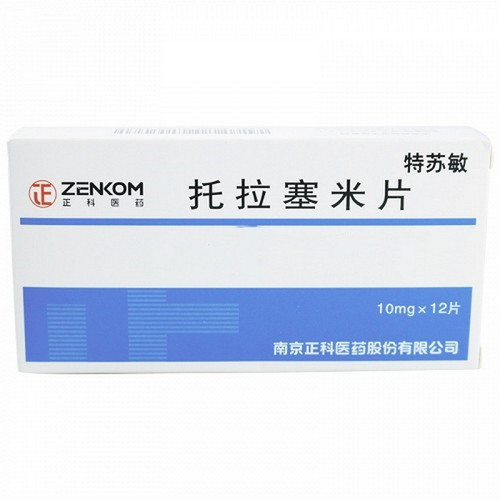Product Overview
[Drug name]
Generic name: Racecadotril granules
Trade name: LeDu Racecadotril granules 10mg*12 bags
Pinyin full code: LeDu XiaoXuanKaDuoQuKeLi 10mg*12Dai
[Main ingredients]
The main ingredient of this product is racecadotril. Chemical name: (±) N-((acetylthio-2-methyl-1-oxo-3-benzylpropyl) glycine benzyl ester Molecular formula: C21H23NO4S Molecular weight: 385.48
[Properties]
This product is white or off-white granules with aromatic odor and slightly sweet taste.
[Indications/Main Functions]
It is used for acute diarrhea in infants and children over 1 month old. Oral rehydration or intravenous rehydration can be given if necessary.
[Precautions]
1. After taking this product for 5 consecutive days, if the diarrhea symptoms still persist, further medical treatment or other drug treatment plans should be adopted. 2. This product can be taken with food, water or breast milk. Please pay attention to dissolving and mixing evenly. 3. Do not take double doses of this product at one time. 4. Use with caution when treating with cytochrome P450-3A4 inhibitors such as erythromycin and ketoconazole (which may reduce the metabolism of racecadotril). 5. Use with caution when treating with cytochrome P450-3A4 inducers such as rifampicin (which may reduce the anti-diarrhea effect of racecadotril).
[Drug Interactions]
Patients with impaired liver and kidney function; patients who cannot ingest fructose, have poor absorption of glucose or galactose, lack sucrase and maltase; patients who are allergic to racecadotril; the above groups are contraindicated.
[Drug Use in Children]
See [Usage and Dosage].
[Drug Use in Elderly Patients]
This experiment has not been conducted and there are no reliable references.
[Drug Use in Pregnant and Lactating Women]
This experiment has not been conducted and there are no reliable references.
[Specification Model]
10mg*12 bags
[Usage and Dosage]
Oral, three times a day, 1.5mg per kilogram of body weight each time; the total daily dose should not exceed 6mg per kilogram of body weight. Continuous use should not exceed 7 days. Oral or intravenous rehydration should be given when necessary. Recommended dose: 1. Infant dosage: 1-9 months (weight < 9kg), 10mg (1 bag) each time, three times a day; 9-30 months (weight 9-13kg), 20mg (2 bags) each time, three times a day. 2. Children's dosage: 30 months to 9 years old (13kg~27kg), 30mg (1 bag) each time, three times a day; 9 years old and above (weight > 27kg), 60mg (2 bags) each time, three times a day.
[Adverse reactions]
Occasionally, drowsiness, rash, constipation, nausea and abdominal pain are seen.
[Contraindications]
Patients with impaired liver and kidney function; patients who cannot ingest fructose, have poor absorption of glucose or galactose, lack sucrase and maltase; patients who are allergic to racecadotril; the above people are contraindicated.
[Pharmacology and toxicology]
1. Pharmacology Racecadotril is an enkephalinase inhibitor. Enkephalinase can degrade enkephalins. This product can selectively and reversibly inhibit enkephalinase, thereby protecting endogenous enkephalins from degradation, prolonging the physiological activity of endogenous enkephalins in the digestive tract, and reducing excessive secretion of water and electrolytes. Oral racecadotril acts on peripheral enkephalinase, does not affect the enkephalinase activity of the central nervous system, and has no significant effect on gastrointestinal motility and intestinal basal secretion. 2. Toxicology It has been reported in the literature that primates took 100 times the therapeutic dose of racecadotril for 12 months without any toxic reactions. Mice were intraperitoneally injected with racecadotril at a dose of 50 mg/Kg (2 times/day) for 10 days. No toxic reactions were found during the medication period and after withdrawal.
[Pharmacokinetics]
1. Absorption This product can be rapidly absorbed after oral administration, and the inhibitory effect on endorphinase in plasma appears in 30 minutes. The intensity of the enzyme inhibitory effect is related to the dosage. When the dosage is 1.5 mg/Kg, the enzyme inhibitory effect reaches a peak after 2.5 hours (the enzyme inhibitory effect reaches 90%), and the enzyme inhibitory effect lasts for about 8 hours, and the t1/2 is about 3 hours. 2. Distribution This product has less tissue distribution, and only 1% of the drug is distributed in the tissue. The plasma protein binding rate is 90% (mainly bound to albumin). 3. Metabolism After entering the body, this product is rapidly converted into its active metabolite Thiorphan, that is, (±) N-(1-oxy-2-mercaptomethyl-3-phenylpropyl) glycine, and then converted into inactive metabolites disulfide and mercaptomethyl ether, and finally excreted through urine, feces and lungs. This product has no inducing effect on the cytochrome P450 enzyme system in the body. 4. Elimination Radiolabeling studies have found that this product is mainly excreted through feces and urine. Repeated administration does not change the pharmacokinetic properties of this product. Food prolongs the onset of enkephalinase inhibition, but has no effect on peak height and area under the drug-time curve (AUC).






